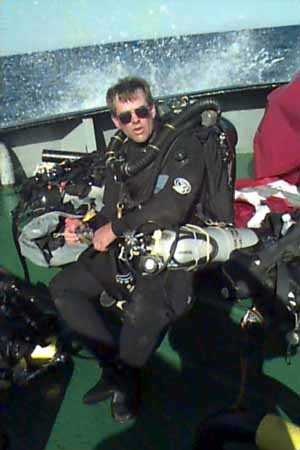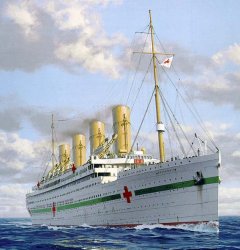

The ship was one the fateful trio of great White Star liners; TITANIC, OLYMPIC and BRITANNIC. As the larger sister ship to the Titanic, she is important in an historic and archaeological sense. Moreover, she remains relatively undisturbed, and offers one of the only available glimpses to the magnificence of the Trans-Atlantic Super Liners of the turn of the century.
HMHS Britannic was lost on only her 6th voyage while serving as a
hospital
off the island of Kea, about 40 miles south east of Athens, Greece on
the
21 November 1916. She was on route to Mudros on the Greek island
of Lemnos to pick up Allied WWI casualties bound for Southampton,
England.
Of the 1,134 people on board, 41 were injured and 30 perished in the
Kea
channel. Tragically, the majority of those who died were killed when
their
lifeboats were sucked under by the still-turning propeller as the stern
of the Britannic started to rise out of the sea.
The most likely cause of the explosion that ripped open her bow compartment was a mine laid by U73 as she passed through the area on the morning of the 28th October 1916. However this still remains unconfirmed despite the efforts of the previous expeditions.
As with the loss of the Titanic, the Britannic sank after sustaining damage that she theoretically should have been able to survive with little difficulty. More surprisingly she sank in only 55 minutes, which was 3 times faster than the Titanic despite the many additional safety features that were included into her design following the Titanic disaster.
The Britannic lay in the Kea channel undisturbed for 60 years until
Jacques Cousteau ran an expedition to locate her from the Calypso in
1975.
She was eventually found 6.75 nautical miles away from its charted
position,
which was quite a surprise due to its proximity to the Island of Kea.
Did
the British Admiralty have something to hide when they originally
charted
her position? How could it have been so wrong? There are many theories
surrounding the reason why the Britannic sank so quickly. These range
from
coal bunker explosions, German sabotage, to a deliberate sinking by the
British to gain sympathy from the Americans and entice them into the
war.
The real reason why she sank is still not known. However, the most
likely
cause is thought to be that she hit a mine laid by U73. Technically she
should have been able to withstand this single impact due to her
enhanced
water tight bulkheads (additional, stronger and higher compared to the
Titanic). However, it is thought that the nurses may have opened many
of
the lower deck portholes to air the wards prior to picking up her next
load of wounded soldiers at Mudros, and effectively negated the safety
aspects of the bulkheads.

On September 2, 1991 the late Captain Bill Nagle and
John Chatterton led a team of experienced amateur shipwreck divers on
an
expedition to explore an unknown wreck at a site approximately 60 miles
east of Point Pleasant, New Jersey. This site was originally suggested
to Captain Nagle by a local fishing boat captain who was curious about
the site he had been fishing for years. Although several experienced
offshore
fishermen were discretely fishing the site, it was relatively unknown,
and had never before been visited by divers.
Upon descending to the wreck, divers discovered what appeared to be the remains of a submarine in approximately 230 feet (77 meters) of salt water. The general appearance was that of a World War II era wreck. On subsequent dives it was discovered that there were human remains aboard the wreck.
Cursory research of area charts and historical records gave no clue as to the wreck's identity. In only a short time the submarine was confirmed to be a World War II German U-boat. It was relatively easy to rule out the possibility that the wreck was one of the two U-boats reportedly lost in the region. The reported sinking of the U-550 (approximately 150 miles north and east of the dive site on April 16, 1944) and that of the U-521 (approximately 110 miles south of the dive site on March 17, 1943) were well documented with submarine survivors. The possibility that the wreck we had located at 39º34' North Latitude, 73º02' West Longitude, was either the U-521 or the U-550 was virtually impossible.
The identity of the wreck was indeed a mystery. The divers nicknamed the wreck the "U-Who" and actively sought to identify the submarine and the men whose remains were still aboard.
Chatterton, over a six year period with the assistance of numerous other divers, historians, and war veterans, found evidence, which positively identifies the wreck of a submarine located approximately sixty miles off the New Jersey coast at 39º 34' North Latitude, 73º 02' West Longitude, as the World War II German Submarine U-869. The U-869 was built at the Deschimag shipyard in Bremen and commissioned into the German Navy on January 26, 1944.
Prior to this date, it has been universally agreed
that
the U-869 was sunk in action at 34º 30'
North Latitude, 8º 30'
North Longitude, by the US Destroyer Escort Fowler and the
French
Submarine Chaser L'Indiscret on February 28, 1945. The
reported
sinking of the U-869 at this location off Gibraltar is incorrect.
|
|
|
|
|
|
|
|
|
|
|
|